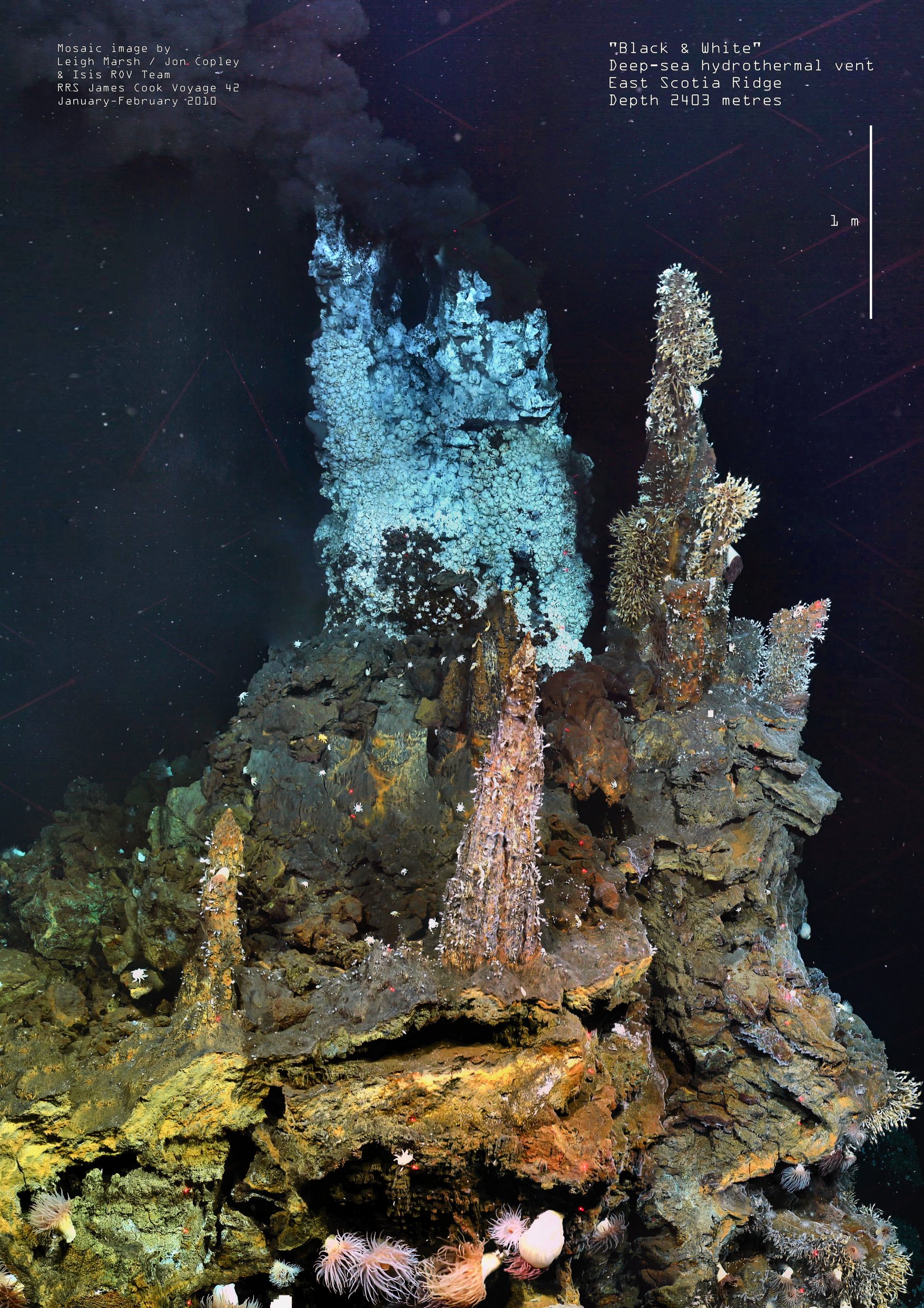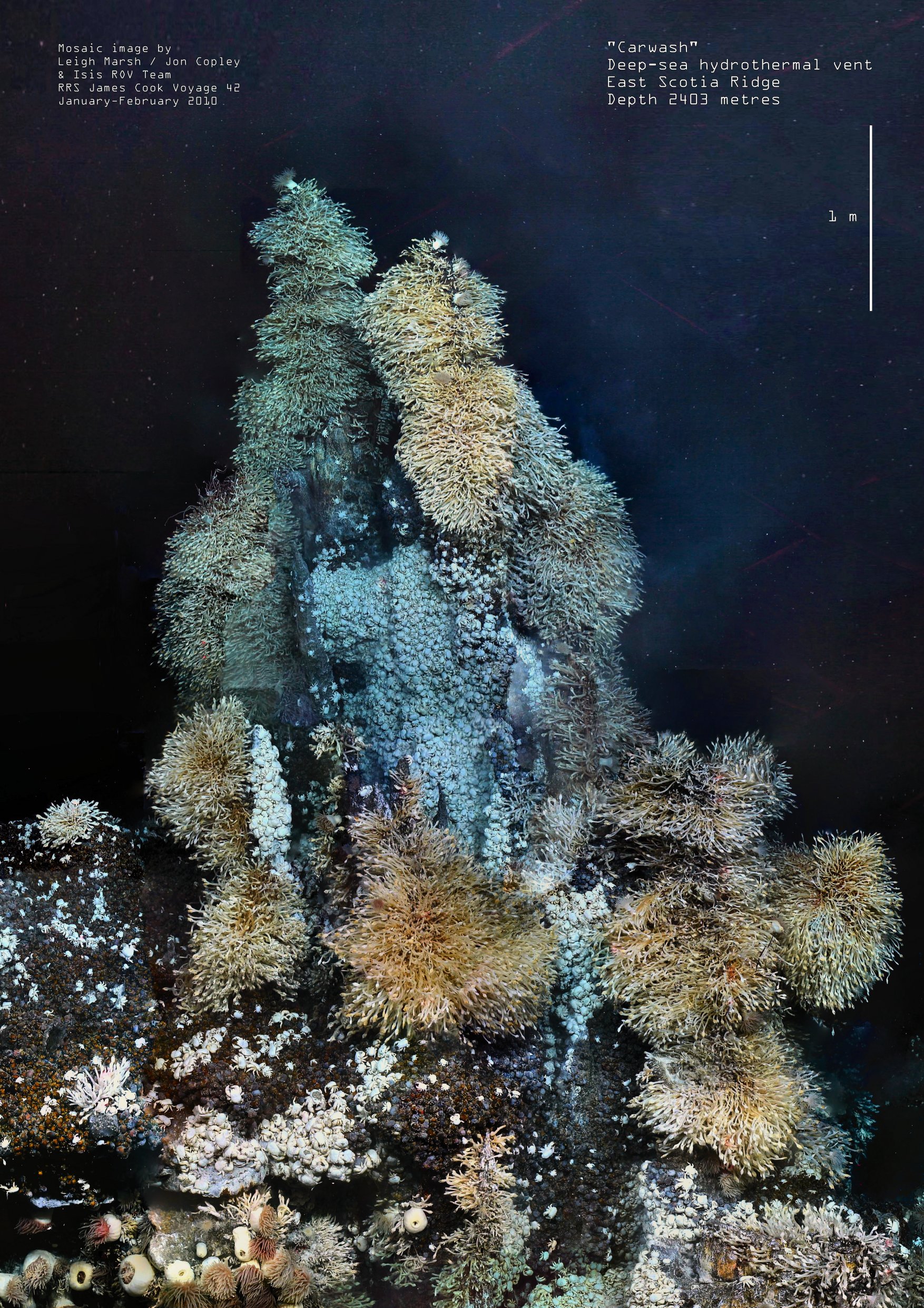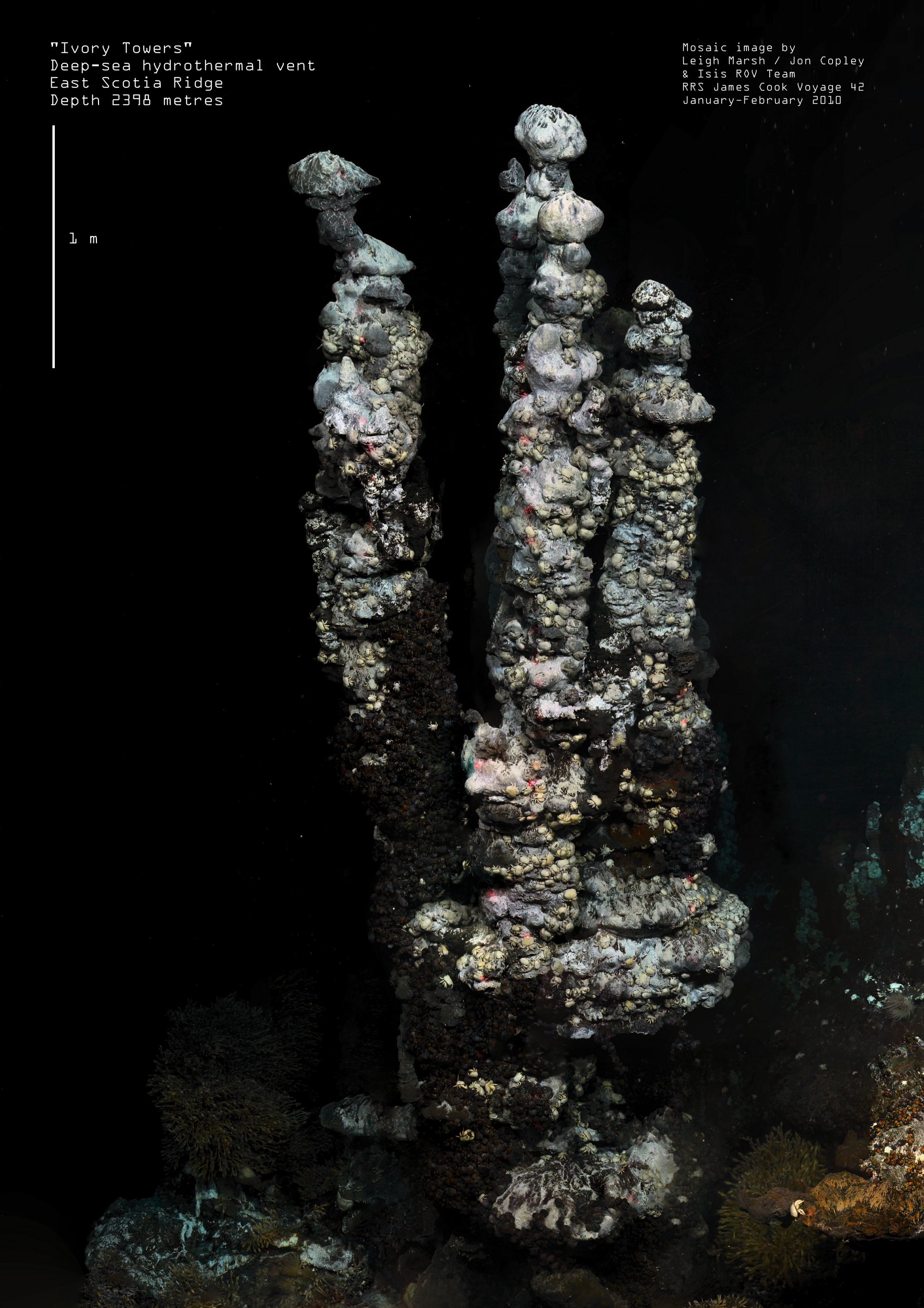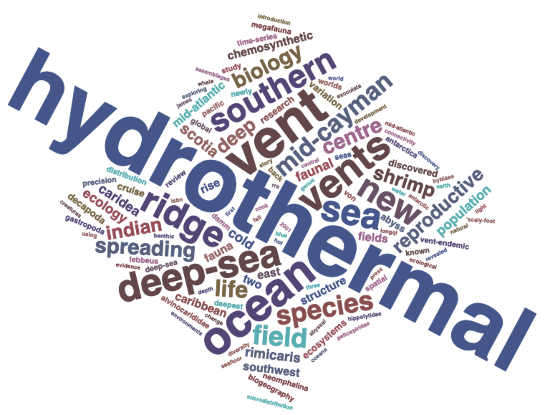My research
The aim of my research has been to understand the patterns of life in deep-sea environments, which face increasing impacts from climate change, pollution, and extraction of resources.
In particular, I have studied island-like seafloor habitats such as hydrothermal vents, cold seeps and whale-falls to investigate ecology ("who does what"), biogeography ("who lives where"), and evolution ("who is related to whom") in the deep ocean.
Exploring those deep-sea habitats has often involved finding new species, and I've been interested in what we can learn from them for medicine and materials science. I have also studied the reproductive biology and life-cycles of deep-sea animals, which may help us to understand their vulnerability to disturbance by human activities.

|

|

|
Hydrothermal vents (click to expand...)
My research has explored hydrothermal vents and other deep-sea habitats in all five regions of the global ocean (Pacific, Atlantic, Indian, Southern & Arctic) as well as in the Cayman Trough and the Gulf of Mexico. My recent projects have investigated the evolution of animal life at hydrothermal vents, the ecological impacts of deep-sea mining, and the biomedical potential of molecules from deep-sea species.
With members of my research team and colleagues around the world, I've co-authored the scientific descriptions of new species including a "scaly-foot snail" with metal plates on its foot (which is teaching us a better way to make solar panels); a shrimp that has a light-sensing patch on its back (& tiny hairs that have inspired a new material for sound and heat insulation); and worms that secrete acid to digest the bones of dead animals on the seafloor (& whose females are thousands of times larger than their microscopic males).

Map of project locations (click to expand...)
I'm currently an Advisory Board member for the global Deep-Ocean Stewardship Initiative (DOSI), and I was previously a Co-Chair of the InterRidge initiative for international cooperation in research at mid-ocean ridges. I'm also a former Scientific Associate of the Natural History Museum in London and a National Geographic Explorer.
I have been supported throughout my work by a team of outstanding doctoral researchers, postdoctoral colleagues, and undergraduate & Masters project students.
Research papers

Frequently occurring words in the titles of my research papers (from Scholar Goggler)
Underlined names below indicate current or former co-supervised doctoral researchers, postdoc research team members, and Masters or undergraduate research project students:
Pending:
Methou P, Mathieu-Resuge M, Michel L, Cueff-Gauchard V, Watanabe H, Cowell E, Copley J, Beinart R, Zbinden M, Pradillon F, Cambon-Bonavita M-A & Chen C (submitted). Evolutionary convergence and trophic diversity in hot vent and cold seep shrimps showcase a continuum of symbiosis. Proceedings of the Royal Society B, submitted.
Zhang M, Chen C, Wu M, Copley JT, Poitrimol C, Alfaro-Lucas JM, Watanabe HK, Zhang R & Zhou Y (submitted). Global barcoding of the deep-sea snail genus Phymorhynchus reveals surprising distribution ranges and genetic diversity. Biology Letters, submitted.
Harris L, Preet G, Desai R, Hasan A, Vad J, Bribiesca-Contreras G, Astakala R, Glover A, Jaspars M & Copley J (submitted). Global distirbution of deep-sea natural products shows environmental and phylogenetic undersampling and potential for biodiscovery. Scientific Reports, submitted.
Glover AG, Arias MB, Bribiesca-Contreras G, Copley JT, Dahlgren TG, Drazen JC, Drennan R, Ingels J, Jones DOB, O'Malley B, Rabone ME & Stewart ECD (submitted). The environmental impacts of deep-sea mining. Current Biology, submitted.
Panieri G, Copley J (joint lead authors), Linse K, Nye V, Ramirez-Llodra E, Argentino C, Ferré B, Rogers A & the Arctic Deep - Extreme24 cruise team (submitted). Deep-sea gas hydrate mounds and chemosynthetic fauna discovered at 3640 m on the Molløy Ridge, Greenland Sea. Nature Communications, submitted.
Published:
Alcock AL, Amon DJ, Bridges AEH, Colaco A, Escobar-Briones E, Hilario A, Howell KL, Mestre NC, Muller-Karger FE, Priede IM, Snelgrove PVR, Sullivan Sealey K, Xavier JR, Amaro T, Bandara G, Bax N, Boschen-Rose R, Braga-Henriques A, Brandt A, Brix S, Cambronero-Solano S, Cedeno-Posso C, Copley JT, Cordes E, Cortes J, Croquer A, Cuvelier D, Davies JS, Durden JM, Esquete P, Foster NL, Frutos I, Gasbarro R, Gates AR, Gomes M, Goodwin LVM, Horton T, Hourigan T, Hoving H-J, Jones DOB, Joshi S, Kingon KC, Lorz A-N, Martins A, Merten V, Metaxas A, Milligan RJ, Molodtsova TN, Morato T, Morrissey D, Naranjo-Elizondo B, Narayanaswamy BE, Olafsdottir SH, Parimbelli A, Pena M, Piechaud N, Ragnarsson S, Ramalho SP, Rodrigues SF, Ross RE, Saeedi H, Santos R, Schwing PT, Serpa T, Shantharam AK, Stevenson A, Yanez Suarez AB, Sutton TT, Svavarsson J, Taylor ML, van der Grient J & Zwerschke N (2025). Deep-sea ecosystems of the North Atlantic Ocean: discovery, status, function and future challenges. Deep-Sea Research I, 104580, https://doi.org/10.1016/j.dsr.2025.104580 (open access).
MacNeil C, Baker M, Copley J, Tyler P, Hilario A & Ramirez-Llodra E (2025). Reproductive biology of two hydrothermal vent Cocculinidae species (Mollusca: Gastropoda) from the Arctic and Southern Ocean. Marine Biology, 172: 114, doi:10.1007/s00227-025-04648-x (open access).
Jones D, Arias MB, Van Audenhauge L, Blackbird S, Boolukos C, Bribiesca-Conreras G, Copley J, Dale A, Evans S, Fleming B, Gates A, Grant H, Hartl M, Huvenne V, Jeffreys R, Josso P, King L, Simon-Lledo E, Le Bas T, Norman L, O'Malley B, Peacock T, Shimmield T, Stewart E, Sweetman A, Wardell C, Aleynik D & Glover A (2025). Long-term impact and biological recovery in a deep-sea mining track. Nature, 642: 112-118, doi:10.1038/s41586-025-08921-3 (open access).
Roterman CN, McArthur M, Laverty Baralle C, Marsh L & Copley JT (2025). Yeti Claws: Cheliped sexual dimorphism and symmetry in deep-sea Yeti crabs (Kiwaidae). PLoS ONE, 20(2): e0314320, doi:10.1372/journal.pone.0314320 (open access).
Methou P, Gueganton M, Copley JT, Kayama Watanabe H, Pradillion F, Cambon-Bonavita M-A & Chen C (2024). Distinct development trajectories and symbiosis modes in vent shrimps. Evolution, 78: 713-722, doi:10.1093/evolut/qpad217 (open access).
Simon-Lledo E, Amon D, Bribiesca-Contreras G, Cuvelier D, Durden J, Ramalho S, Uhlenkott K, Martinez Arbizu P, Benoist N, Copley J, Dahlgren T, Glover A, Fleming B, Horton T, Ju SJ, Mejia-Saenz A, McQuaid K, Pape E, Park C, Smith C & Jones D (2023). Carbonate compensation depth drives abyssal biogeography in the northeast Pacific. Nature Ecology & Evolution, 7: 1388-1397, doi:10.1038/s41559-023-02122-9 (open access).
Methou P, Nye V, Kayama Watanabe H, Copley JT, Nagai Y & Chen C (2023). Life-history traits of alvinocaridid shrimps inhabiting chemosynthetic ecosystems around Japan. Marine Biology, 170: 75, doi:10.1007/s00227-023-04221-4.
Georgieva M, Rimskaya-Korsakova N, Krolenko V, Van Dover C, Amon D, Copley J, Plouviez S, Ball B, Wiklund H & Glover A (2023). A tale of two tubeworms: taxonomy of vestimentiferans (Annelida: Siboglinidae) from the Mid-Cayman Spreading Centre. Invertebrate Systematics, 37: 167-191, doi:10.1071/IS22047.
Stefanoudis P, Biancani LM, Cambronero-Solano S, Clark MR, Copley JT, Easton E, Elmer F, Haddock SHD, Herrera S, Iglesias IS, Quattrini AM, Sigwart J, Yesson C & Glover AG (2021). Moving conferences online: lessons learned from an international virtual meeting. Proceedings of the Royal Society B, 288: 20211769, doi:10.1098/rspb.2021.1769 (open access).
Chen C, Han Y, Copley J & Zhou Y (2021). A new peltospirid snail (Gastropoda: Neomphalida) adds to the unique biodiversity of Longqi vent field, Southwest Indian Ridge. Journal of Natural History, 55: 851-866, doi:10.1080/00222933.2021.1923851.
Howell K, Hilario A, Allcock L, Bailey D, Baker M, Clark M, Colaço A, Copley J, Cordes E, Danovaro R, Dissanayake A, Escobar E, Esquete P, Gallagher A, Gates A, Gaudron S, German C, Gjerde K, Higgs N, Le Bris N, Levin L, Manea E, McClain C, Menot L, Mestre N, Metaxas A, Milligan R, Muthumbi A, Narayanaswamy B, Ramalho S, Ramirez-Llodra E, Robson L, Rogers A, Sellanes J, Sigwart J, Sink K, Snelgrove P, Stefanoudis P, Sumida P, Taylor M, Thurber A, Rui Vieira P, Watanabe H, Woodall L & Xavier J (2021). A decade to study deep-sea life. Nature Ecology & Evolution, 5: 265-267, doi:10.1038/s41559-020-01352-5.
Howell K, Hilario A, Allcock L, Bailey D, Baker M, Clark M, Colaço A, Copley J, Cordes E, Danovaro R, Dissanayake A, Escobar E, Esquete P, Gallagher A, Gates A, Gaudron S, German C, Gjerde K, Higgs N, Le Bris N, Levin L, Manea E, McClain C, Menot L, Mestre N, Metaxas A, Milligan R, Muthumbi A, Narayanaswamy B, Ramalho S, Ramirez-Llodra E, Robson L, Rogers A, Sellanes J, Sigwart J, Sink K, Snelgrove P, Stefanoudis P, Sumida P, Taylor M, Thurber A, Rui Vieira P, Watanabe H, Woodall L & Xavier J (2020). A blueprint for an inclusive, global deep-sea Ocean Decade field programme. Frontiers in Marine Science, 7: 584861, doi:10.3389/fmars.2020.584861 (open access).
Thomas EA, Liu R, Amon D, Copley JT, Glover AG, Helyar SJ, Olu K, Wiklund H, Zhang H & Sigwart JD (2020). Chiridota heheva - the cosmopolitan holothurian. Marine Biodiversity, 50: 110, doi:10.1007/s12526-020-01128-x (open access).
Reid WDK, Wigham BD, Marsh L, Weston JNJ, Zhu Y & Copley JT (2020). Trophodynamics at the Longqi hydrothermal vent field and comparison with the East Scotia and Central Indian Ridges. Marine Biology, 167: 141, doi:10.1007/s00227-020-03755-1 (open access).
Georgieva MN, Taboada S, Riesgo A, Díez-Vives C, De Leo FC, Jeffreys RM, Copley J, Little CTS, Ríos P, Cristobo J, Hestetun JT & Glover AG (2020). Evidence of vent-adaptation in sponges living at the periphery of hydrothermal vent environments: ecological and evolutionary implications. Frontiers in Microbiology, 11: 1636, doi:10.3389/fmicb.2020.01636 (open access).
Linse K, Copley JT, Connelly DP, Larter RD, Pearce DA, Polunin NVC, Rogers AD, Chen C, Clarke A, Glover AG, Graham AGC, Huvenne VAI, Marsh L, Reid WDK, Roterman CN, Sweeting CJ, Zwirglmaier K & Tyler PA (2019). The fauna of the Kemp Caldera and its upper bathyal hydrothermal vents (South Sandwich Arc, Antarctica). Royal Society Open Science, 6: 191501, doi:10.1098/rsos.191501 (open access).
Linse K, Nye V (joint lead authors), Copley JT & Chen C (2019). On the systematics and ecology of two new species of Provanna (Abyssochrysoidea: Provannidae) from deep-sea hydrothermal vents in the Caribbean Sea and Southern Ocean. Journal of Molluscan Studies, eyz024, doi:10.1093/mollus/eyz024.
Chapman A, Beaulieu S, Colaco A, Gebruk A, Hilario A, Kihara T, Ramirez-Llodra E, Sarrazin J, Tunnicliffe V, Amon D, Baker M, Boschen-Rose R, Chen C, Cooper I, Copley J, Corbari L, Cordes E, Cuvelier D, Duperron S, Du Preez C, Gollner S, Horton T, Hourdez S, Krylova E, Linse K, LokaBharathi PA, Marsh L, Matabos M, Mills S, Mullineaux L, Rapp H-T, Reid W, Rybakova (Goroslavskaya) E, Thomas T, Southgate S, Stohr S, Turner P, Watanabe H, Yasuhara M, Bates A (2019). sFDvent: a global trait database for deep-sea hydrothermal vent fauna, Global Ecology and Biogeography, 28: 1538-1551, doi:10.1111/geb.12975 (open access).
Fielding S, Copley JT & Mills RA (2019). Exploring Our Oceans: using the global classroom to develop ocean literacy. Frontiers In Marine Science, 6: 340, doi: 10.3389/fmars.2019.00340 (open access).
Copley J (2018). Providing evidence of "impact" from public engagement with research: a case study from the UK's Research Excellence Framework (REF). Research For All, 2(2): 230-243, doi:10.18546/RFA.02.2.03 (open access).
Chen C, Marsh L & Copley JT (2018). Is it sex in chains? Potential mating stacks in deep-sea hydrothermal vent snails. Plankton and Benthos Research, 13: 25-17, doi:10.3800/pbr.13.25 (open access).
Chen C, Zhou Y, Wang C & Copley JT (2017). Two new hot-vent peltospirid snails (Gastropoda: Neomphalina) from Longqi hydrothermal field, Southwest Indian Ridge. Frontiers in Marine Science, 4: 392, doi: 10.3389/fmars.2017.00392 (open access).
Amon DJ, Copley JT, Dahlgren TG, Horton T, Kemp KM, Rogers AD & Glover AG (2017). Observations of fauna attending wood and bone deployments from two seamounts on the Southwest Indian Ridge. Deep-Sea Research II, 136: 122-132, doi:10.1016/j.dsr2.2015.07.003.
Copley JT, Marsh L, Glover AG, Huhnerbach V, Nye VE, Reid WDK, Sweeting CJ, Wigham BD & Wiklund H (2016). Ecology and biogeography of megafauna and macrofauna at the first known deep-sea hydrothermal vents on the ultraslow-spreading Southwest Indian Ridge. Scientific Reports, 6: 38158, doi:10.1038/srep39158 (open access).
Press release
Roterman CN, Copley JT, Linse KT, Tyler PA & Rogers AD (2016). Connectivity in the cold: the comparative population genetics of vent-endemic fauna in the Scotia Sea, Southern Ocean. Molecular Ecology, 25: 1073-1088, doi:10.1111/mec.13541.
Anderson ME, Somerville R & Copley JT (2016). A new species of Pachycara Zugmayer, 1911 (Teleostei: Zoarcidae) from deep-sea chemosynthetic environments in the Caribbean Sea. Zootaxa, 4066 (1): 071-077, doi:10.11646/zootaxa.4066.1.5 (open access).
Chen C, Linse K, Roterman CN, Copley J & Rogers AD (2015). A new genus of large hydrothermal vent-endemic gastropod (Neomphalina: Peltospiridae). Zoological Journal of the Linnean Society, 175: 319-335, doi:10.1111/zoj.12279.
Chen C, Copley JT, Linse K & Rogers AD (2015). Low connectivity between 'scaly-foot gastropod' (Mollusca: Peltospiridae) populations at hydrothermal vents on the Southwest Indian Ridge and the Central Indian Ridge. Organisms Diversity and Evolution, 15: 663-670, doi:10.1007/s13127-015-0224-8.
Chen C, Copley JT, Linse K, Rogers AD & Sigwart JD (2015). The heart of a dragon: 3D anatomical reconstruction of the 'scaly-foot' gastropod (Mollusca: Gastropoda: Neomphalina) reveals its extraordinary circulatory system. Frontiers in Zoology, 12: 13, doi:10.1186/s12983-015-0105-1 (open access).
Mah C, Linse K, Copley J, Marsh L, Rogers A, Clague D & Foltz D (2015). Description of a new family, new genus, and two new species of deep-sea Forcipulatacea (Asteroidea), including the first known sea-star from hydrothermal vent habitats. Zoological Journal of the Linnean Society, 174: 93-113, doi:10.1111/zoj.12229.
Press release
Chen C, Linse K, Copley JT & Rogers AD (2015). The 'scaly-foot gastropod': a new genus and species of hydrothermal vent-endemic gastropod (Neomphalina: Peltospiridae) from the Indian Ocean. Journal of Molluscan Studies, 81: 322-334, doi:10.1093/mollus/eyv013 (open access).
Amon DJ, Sykes D, Ahmed F, Copley JT, Kemp KM, Tyler PA, Young C & Glover AG (2015). Burrow forms, growth rates and feeding rates of wood-boring Xylophagaidae bivalves revealed by micro-computed tomography. Frontiers in Marine Science, 2: 10, doi:10.3389/fmars.2015.00010 (open access).
Marsh L, Copley J, Tyler PA & Thatje S (2015). In hot and cold water: differential life-history traits are key to success in contrasting thermal deep-sea environments. Journal of Animal Ecology, 84: 898-913, doi:10.1111/1365-2656.12337 (open access).
Press release
Chen C, Copley J, Linse K, Rogers A & Sigwart J (2015). How the mollusc got its scales: convergent evolution of the molluscan scleritome. Biological Journal of the Linnean Society, 114: 949-954, doi:10.1111/bij.12462.
Nye VE & Copley JT (2014). The reproductive biology of Lebbeus virentova (Caridea: Hippolytidae) at the Von Damm Vent Field, Mid-Cayman Speading Centre, Caribbean. Marine Biology, 161: 2371-2380, doi:10.1007/s00227-014-2512-9.
Van Dover C, Bell K, Marsh L, German C, John B, Cheadle M, Vecchione M, Amon D, Ball B, Copley J, Smart C, Fuller S, Phillips B, Cantner K, Auscavitch S & Ballard B (2014). Exploration of the Mid-Cayman Rise. Oceanography, 27: 32-33.
Amon DJ, Wiklund H, Dahlgren T, Copley JT, Smith CR, Jamieson AJ, & Glover AG (2014). Molecular taxonomy of Osedax (Annelida: Siboglinidae) in the Southern Ocean. Zoologica Scripta, 4: 405-417, doi:10.1111/zsc.12057.
Wheeler A, Murton B, Copley J, Lim A, Carlsson J, Collins P, Dorschel B, Green D, Judge M, Nye V, Benzie J, Antoniacomi A, Coughlan M & Morris K (2013). Moytirra: discovery of the first known deep-sea hydrothermal vent field on the slow-spreading Mid-Atlantic Ridge north of the Azores. Geochemistry Geophysics Geosystems, 14: 4170-4184, doi:10.1002/ggge.20243.
Collins PC, Kennedy B, Copley JT, Boschen RE, Fleming N, Forde J, Se-Jong J, Lindsay D, Marsh L, Nye VE, Patterson A, Watanabe H, Yamamoto H, Carlsson J & Thaler AD (2013). VentBase: Developing a consensus among stakeholders in the deep-sea regarding environmental impact assessment for deep-sea mining - a workshop report. Marine Policy, 42: 334-336, doi:10.1016/j.marpol.2013.03.002.
Roterman CN, Copley JT, Linse KT, Tyler PA & Rogers AD (2013). The biogeography of the yeti crabs (Kiwaidae) with notes on the phylogeny of the Chirostyloidea (Decapoda: Anomura). Proceedings of the Royal Society B, 280: 2013718, doi:0.1098/rspb.2013.0718 (open access).
Press release
Nye VE, Copley JT, Linse K & Plouviez S (2013). Iheyaspira bathycodon new species (Vetigastropoda: Trochoidea: Turbinidae: Skeneinae) from the Von Damm Vent Field, Mid-Cayman Spreading Centre, Caribbean. Journal of the Marine Biological Association of the UK, 94: 1017-1024, doi:10.1017/S002531541200082 (full pdf available here; publication is (c) Cambridge University Press).
Nye VE, Copley JT, Plouviez S & Van Dover CL (2013). A new species of Lebbeus (Crustacea: Decapoda: Caridea: Hippolytidae) from the Von Damm Vent Field, Caribbean Sea. Journal of the Marine Biological Association of the UK, 93: 741-751, doi:10.1017/S0025315412000884 (full pdf available here; publication is (c) Cambridge University Press).
Roterman CN, Copley JT, Linse KT, Tyler PA & Rogers AD (2013). Development of polymorphic microsatellite loci for three species of vent-endemic megafauna from deep-sea hydrothermal vents in the Scotia Sea, Southern Ocean. Conservation Genetics Resources, doi:10.1007/s12686-013-9921-9.
Nye VE, Copley JT & Tyler PA (2013). Spatial variation in the population structure and reproductive biology of Rimicaris hybisae (Caridea: Alvinocarididae) at hydrothermal vents on the Mid-Cayman Spreading Centre. PLoS ONE, 8(3): e60319, doi:10.1371/journal.pone.0060319 (open access).
Nye VE, Copley JT & Linse K (2013). A new species of Eualus Thallwitz, 1891 and new record of Lebbeus antarcticus (Hale, 1941) (Crustacea: Decapoda: Caridea: Hippolytidae) from the Scotia Sea. Deep-Sea Research II, 92: 145-156, doi:10.1016/j.dsr2.2013.01.022.
Marsh L, Copley JT, Huvenne VAI, Tyler PA & the NERC Deep-Platforms Team (2013). Getting the bigger picture: using precision Remotely Operated Vehicle (ROV) videography to construct high-definition mosaic images of newly discovered deep-sea hydrothermal vents in the Southern Ocean. Deep-Sea Research II, 92: 124-135, doi:10.1016/j.dsr2.2013.02.007.
Amon DJ, Glover AG, Wiklund H, Marsh L, Linse K, Rogers AD & Copley JT (2013). The discovery of a natural whale fall in the Antarctic deep sea. Deep-Sea Research II, 92: 87-96, doi:10.1016/j.dsr2.2013.01.028.
Press release
Boschen RE, Tyler PA & Copley JT (2013). Distribution, population structure, reproduction and diet of Ophiolimna antarctica (Lyman, 1879) from Kemp Caldera in the Southern Ocean. Deep-Sea Research II, 92: 27-35, doi:10.1016/j.dsr2.2013.02.005.
Aquilina A, Connelly DP, Copley JT, Green DRH, Hawkes JA, Hepburn LE, Huvenne VAI, Marsh L, Mills RA & Tyler PA (2013). Geochemical and visual indicators of hydrothermal fluid flow through a sediment-hosted volcanic ridge in the central Bransfield Basin. PLoS ONE, 8(1): e54686, doi:10.1371/journal.pone.0054686 (open access).
Marsh L, Copley JT, Huvenne VAI, Linse K, Reid WDK, Rogers AD, Sweeting CJ & Tyler PA (2012). Microdistribution of faunal assemblages at deep-sea hydrothermal vents in the Southern Ocean. PLoS ONE, 7(10): e48348, doi:10.1371/journal.pone.0048348 (open access).
Nye V, Copley J & Plouviez S (2012). A new species of Rimicaris (Crustacea: Decapoda: Caridea: Alvinocarididae) from hydrothermal vent fields on the Mid-Cayman Spreading Centre, Caribbean. Journal of the Marine Biological Association of the UK, 92: 1057-1072, doi:10.1017/S0025315411002001 (full pdf available here; publication is © Cambridge University Press).
Connelly DP, Copley JT (joint lead authors), Murton BJ, Stansfield K, Tyler PA, German CR, Van Dover CL, Amon D, Furlong M, Grindlay N, Hayman N, Huhnerbach V, Judge M, Le Bas T, McPhail S, Meier A, Nakamura K, Nye VE, Pebody M, Pedersen RB, Plouviez S, Sands C, Searle RC, Stevenson P, Taws S & Wilcox S (2012). Hydrothermal vent fields and chemosynthetic biota on the world's deepest seafloor spreading centre. Nature Communications, 3: 620, doi:10.1038/ncomms1636 (open access).
Press release
Rogers AD, Tyler PA, Connelly DP, Copley JT, James R, Larter RD, Linse K, Mills RA, Naveira-Garabato A, Pancost RD, Pearce DA, Polunin NVC, German CR, Shank T, Alker B, Aquilina A, Bennett SA, Clarke A, Dinley RJJ, Graham AGC, Green D, Hawkes JA, Hepburn L, Hilario A, Huvenne VAI, Marsh L, Ramirez-Llodra E, Reid WDK, Roterman CN, Sweeting CJ, Thatje S & Zwirglmaier K (2012). The discovery of new deep-sea hydrothermal vent communities in the Southern Ocean and implications for biogeography. PLoS Biology, 10(1): e1001234, doi:10.1371/journal.pbio.1001234 (open access).
Press release
Cuvelier D, Sarrazin J, Colaco A, Copley J, Glover A, Tyler P, Serrao Santos R & Desbruyeres D (2011). Community dynamics over 14 years at the Eiffel Tower hydrothermal edifice on the Mid-Atlantic Ridge. Limnology & Oceanography, 56: 1624-1640.
Cuvelier D, Sarradin P-M, Sarrazin J, Colaco A, Copley J, Desbruyeres D, Glover A, Serrao Santos R & Tyler P (2011). Hydrothermal faunal assemblages and habitat characterisation at the Eiffel Tower edifice (Lucky Strike, Mid-Atlantic Ridge). Marine Ecology, 32: 243-255.
Glover AG, Gooday AJ, Bailey BM, Billett DSM, Chevaldonne P,
Colaco A, Copley J, Cuvelier D, Desbruyeres D, Kalogeropoulou V, Klages M,
Lampadariou N, Lejeusne C, Mestre NC, Paterson GLJ, Perez T, Ruhl H, Sarrazin J,
Soltwedel T, Soto EH, Thatje S, Tselepides A, Van Gaever S & Vanreusel A (2010). Temporal change in deep-sea benthic ecosystems: a review of the evidence from recent time-series studies.
Advances in Marine Biology, 58: 1-95.
Vanreusel A, Fonseca G, Danavaro R, da Silva M, Esteves A, Ferrero T, Gad G, Galtsova V, Gambi C, da Fonseca Genevois V, Ingels J, Ingole B, Lampadariou N, Merckx B, Miljutin D, Miljutina M, Muthumbi A, Netto S, Portnova D, Radziejewska T, Raes M, Tchesunov A, Vanaverbeke J, Van Gaever S, Venekey V, Bezerra T, Flint H, Copley J, Pape E, Zeppilli D, Martinez P & Galeron J (2010). The contribution of deep-sea microhabitat heterogeneity to global nematode diversity. Marine Ecology, 31: 6-20.
Larkin KE, Ruhl HA, Bagley P, Benn A, Bett BJ, Billett DSM, Boetius A, Chevaldonne P, Colaco A, Copley J, Danovaro R, Escobar-Briones E, Glover A, Gooday AJ, Hughes JA, Kalogeropoulou V, Kitazato H, Kelly-Gerreyn BA, Klages M, Lampadariou N, Lejeusne C, Perez T, Priede IG, Rogers A, Sarradin PM, Sarrazin J, Soltwedel T, Soto EH, Thatje S, Tselepides A, van den Hove S, Tyler PA, Vanreusel A & Wenzhofer F (2010). Benthic biology time-series in the deep sea: indicators of change. In: Hall J, Harrison DE & Stammer D (eds), Proceedings of OceanObs'09: Sustained Ocean Observations and Information for Society, 2: 599-615 (European Space Agency Special Publication WPP-306).
Cuvelier D, Sarrazin J, Colaco A, Copley J, Desbruyeres D, Glover A, Tyler P
& Serrao Santos R (2009). Distribution and spatial variation of hydrothermal
faunal assemblages at Lucky Strike (Mid-Atlantic Ridge) revealed by
high-resolution video image analysis. Deep-Sea Research I, 56: 2026-2040.
Copley JTP, Flint HC, Ferrero TJ & Van Dover CL (2007). Diversity of
meiofauna and free-living nematodes in mussel beds at hydrothermal vents on the
northern and southern East Pacific Rise. Journal of the Marine Biological
Association of the UK, 87: 1141-1152, doi:10.1017/S0025315407055956 (full pdf available here; publication is (c) Cambridge University Press).
Copley JT (2007). Audio and video podcasts of lectures for campus-based
students: production and evaluation of student use. Innovations in Education
and Teaching International, 44: 387-399.
Copley JTP, Jorgensen PBK & Sohn RA (2007). Assessment of decadal-scale
ecological change at a deep Mid-Atlantic hydrothermal vent and reproductive
time-series in the shrimp Rimicaris exoculata. Journal of the Marine
Biological Association of the UK, 87: 859-867,
doi:10.1017/S0025315407056512 (full pdf available here; publication is (c) Cambridge University Press).
Flint HC, Copley JTP, Ferrero TJ & Van Dover CL (2006). Patterns of
nematode diversity at hydrothermal vents on the East Pacific Rise. Cahiers de
Biologie Marine, 47: 365-370.
Copley JTP & Young CM (2006). Seasonality and zonation in the
reproductive biology and population structure of the shrimp Alvinocaris
stactophila (Caridea: Alvinocarididae) at a Louisiana Slope cold seep.
Marine Ecology Progress Series, 315: 199-209, doi:10.3354/meps315199
Copley JTP, Tyler PA, Van Dover CL & Philp S (2003). Spatial variation in
the reproductive biology of Paralvinella palmiformis (Polychaeta:
Alvinellidae) from a vent field on Juan de Fuca Ridge. Marine Ecology
Progress Series, 255: 171-181, doi:10.3354/meps225171
Allen CE, Copley JT & Tyler P (2001). Lipid partitioning in the
hydrothermal vent shrimp Rimicaris exoculata. PSZNI: Marine
Ecology, 22: 241-253.
Ramirez Llodra E, Tyler PA & Copley JTP (2000). Reproductive biology of
three caridean shrimp, Rimicaris exoculata, Chorocaris chacei and
Mirocaris fortunata (Caridea: Decapoda), from hydrothermal vents.
Journal of the Marine Biological Association of the UK, 80:
473-484.
Copley JTP, Tyler PA, Van Dover CL, Schultz A, Dickson P, Singh S &
Sulanowska M (1999). Subannual temporal variation in faunal distributions at the
TAG hydrothermal mound (26N, Mid-Atlantic Ridge). PSZNI: Marine Ecology,
20: 291-306.
Copley JTP, Tyler PA, Murton BJ & Van Dover CL (1997). Spatial and
interannual variation in the faunal distribution at Broken Spur vent field (29N,
Mid-Atlantic Ridge). Marine Biology, 129: 723-733.
Copley JTP, Tyler PA, Sheader M, Murton BJ & German CR (1996). Megafauna
from sublittoral to abyssal depths along the Mid-Atlantic Ridge south of
Iceland. Oceanologica Acta, 19: 549-559.





